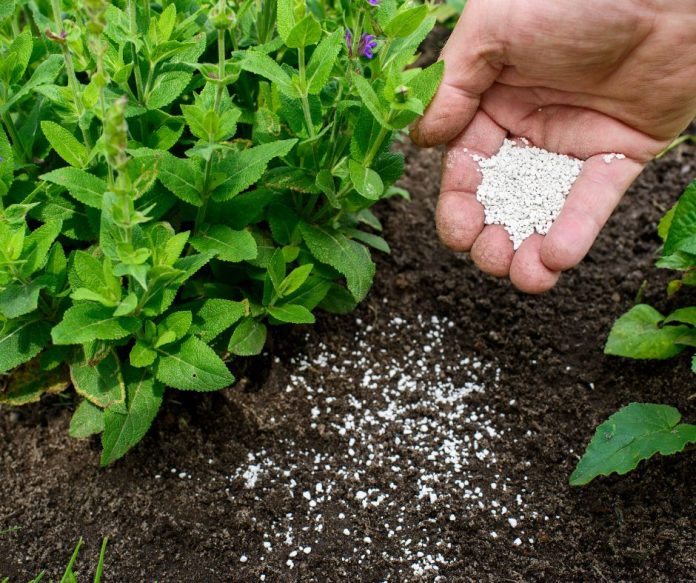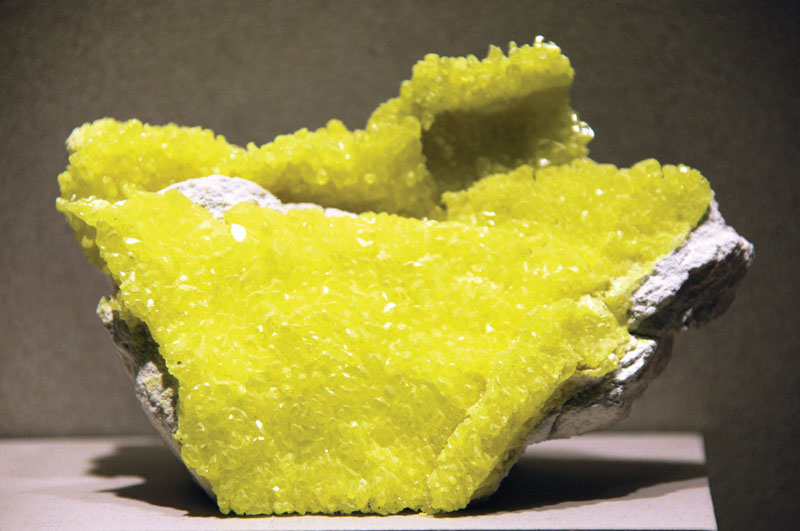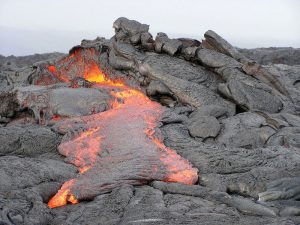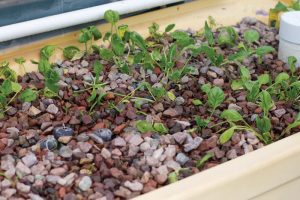
Plant growth is derived from nutrients from the air, water or soil. For millions of years before the advent of commercially available synthetic fertilizers, many of those nutrients in the soil came from the mineralization of rocks. To this day, rocks are still the backbone of many commercial formulations of fertilizers.
What Minerals Fuel Plant Growth?
All plants need some combination of 17 different elements at a minimum to survive, thrive, and complete their biological processes. Each plant may require additional nutrients, but in general, all require these same 17 for plant growth. These nutrients are further broken down into macro-and micro-nutrients depending on the volume typically required for plant growth. Some classifications further break down the elements plants need into primary, secondary and micro-nutrients. Three of these necessary nutrients plants can obtain from air and water – carbon (C), hydrogen (H) and oxygen (O). The remaining elements are obtained through rocks.

PRIMARY NUTRIENTS
• Nitrogen (N) -This is important for the production of chlorophyll in plant leaves. It also aids in the healthy growth of leaves, stems and branches.
• Phosphorus (P) -Phosphorus aids in all energy transfers in the plants, this includes but is not limited to root growth, flower development and fruit set.
• Potassium (K) -This aids in the absorption of CO2 and feeds developing plants.
SECONDARY NUTRIENTS
• Calcium (Ca)- Calcium helps transport nutrients from the roots throughout the plant and helps to build strong cell walls.
• Magnesium (Mg)- This helps to activate different life cycles and stages of plant growth and aids in photosynthesis.
• Sulfur (S)- Sulfur is a major component of essential oils in plants and helps nitrogen to create chlorophyll.

MICRO-NUTRIENTS
• Boron (B)- Boron helps plants to absorb Ca and to form cellular walls.
• Chlorine (Cl)- Chlorine helps to regulate water loss through plant leaves and also helps with the transport of nutrients through the plant.
• Copper (Cu)- Copper helps with the production of flowers, fruit and seeds.
• Iron (Fe)- Iron carries oxygen to the cells and helps to produce chlorophyll.
• Manganese (Mo)- Manganese helps plants to use iron and to help trigger new growth.
• Molybdenum (Mb)- This element is critical for pollen formation and to process both nitrogen and phosphorus.
• Nickel (Ni)- Nickel helps plants to metabolize nitrogen.
• Zinc (Zn)- Zinc helps metabolize the carbohydrates that produce growth hormones in the plant.
Where are Minerals for Plant Growth Found?
Minerals needed for plant growth are found all over the surface of the earth. Sedimentary rock covers up to 80 percent of the Earth’s crust and is the primary component of soil. The type of rock and its components varies widely, but fortunately, many different types of rocks are comprised of many of the same minerals.
Feldspars, for instance, provide potassium, calcium, copper and manganese. Micas provide all of the same minerals as feldspars but additionally provide magnesium, iron, zinc, nickel, and copper. Clay can provide additional potassium, magnesium, iron, and calcium. In many soils around the world, up to 90 percent of the potassium is found within the structure of these minerals. Carbonates not only provide a source for calcium and magnesium, but they also trap and store those elements, acting as a sink for them.
How do Minerals Get Into the Soil?
Biological processes and physical weathering release minerals over time and produce healthy soil. As parental rock material decomposes and interacts with microbial activity and the decomposition of other organic materials, minerals are released and available in usable forms for plants.
The amount of time this takes varies and the type of rock and climate play a role in how long it takes to start to weather and release minerals. For example, one micrometer (?m) of granite will take 1,000 years to weather in a cold climate, but 100 years in a warm or humid climate. Marble will take 50 years for one micrometer (?m) to weather, but only five years in a hot or humid climate.

This is not a one-way exchange though. Rocks are not simply breaking down and not being replaced. They are part of a larger geological cycle. New minerals are being formed all of the time, especially in the aqueous phase of many environments. As old minerals are being released by rocks into soils, those that are not utilized by plants are available to be reformed into new rocks through many geologic eras. Volcanoes also release new minerals from deep inside the earth. Some of the world’s most fertile soils are located in proximity to active volcanoes. It explains why some civilizations choose to risk their lives living so close to danger.
Rock Minerals as Plant Fertilizer
All minerals are not evenly distributed. Humankind is also constantly introducing new species of plants into environments where they did not evolve, for better or worse. These introduced species may have higher nutrient needs than their new soils have. Other times, intensive farming practices cause existing mineral stores, that may have been present in sufficient amounts for native plants, to be depleted and additional nutrients to be reintroduced to the soil. When this need arises, many plant producers and farmers add minerals, directly derived from rock back into their soil.
Responsible growers perform soil analyses to learn what is present in their soils. Soils can then be amended, usually in the form of rock dust, and recreate a natural environment for that species.
Getting Minerals from Rock
The availability of minerals and a particular type of rock’s ability to be reduced to its constituent components varies greatly. For example, both granite and basalt have extremely high mineral content. Basalt, however, is much easier to work with and provides a slow release of necessary nutrients over time, making it a preferred source of plant minerals compared to other rock types.

cogdogblog is licensed under CC PDM 1.0
Plant Growth Directly in Gravel
Some growers take this a step further. They grow plants from seed straight through to harvest in gravel made of sedimentary rock – this is called geological agriculture, gravel gardening or even geo-agriculture. This form of soilless plant growth relies at least partially on the release of needed plant nutrients from the gravel. The constant presence of moisture aids in the quicker release of the stored nutrients in the stones, making them available to the plants.
Nutrients from rocks is nothing new. For millennia, it was likely the primary, if not the only source of minerals for plants. Somewhere along the line though, with the advent of industrial agriculture, farmers started removing rocks from the soil since they would do damage to plows and other farming implements when struck. Since the advent of organic gardening, growers have begun adding rocks back into the soil to gain nutrients, even if only in the form of rock dust. Like with so many things, everything old is new again.
What Happens When Plants Don’t Get the Required Amounts of Minerals?
Not all mineral deficiencies in plants are obvious. Some are difficult to determine or differentiate from other deficiencies. Here are some of the more common symptoms and implications of plants not getting needed minerals in sufficient quantities.
PRIMARY NUTRIENTS
• Nitrogen (N)- The oldest leaves, generally at the bottom of the plant turn yellow.
• Phosphorus (P)- Tips of new leaves appear burnt. Older leaves turn red or purple.
• Potassium (K)- Older leaves look wilted and burned on the margins
SECONDARY NUTRIENTS
• Calcium (Ca)- Newest leaves, generally at the top of the plant, look misshapen or distorted.
• Magnesium (Mg)- Edges of older leaves turn yellow.
• Sulfur (S)- All leaves turn yellow, starting at the youngest leaves and working their way through the oldest in succession.
MICRO-NUTRIENTS
• Boron (B)- Youngest leaves are splotchy yellow and new growth is misshapen and brittle.
• Chlorine (Cl)- Leaves start to wilt and die at the margins, then the entire leaf curls and dies.
• Copper (Cu)- Leaves are stunted and abnormally dark green.
• Iron (Fe)- Veins of young leaves turn yellow (chlorosis).
• Manganese (Mo)- Yellowing between the veins of the youngest leaves, but not as pronounced as an Iron deficiency.
• Molybdenum (Mb)- Oldest leaves turn yellow while the rest of the plant turns light green.
• Nickel (Ni)- Leaf tips die, newer leaves are undersized and veins are yellow.
• Zinc (Zn)- Outer leaves at the end of each stem are misshapen and turn yellow between the leaf veins.
This story about the role of rocks and minerals in plant growth previously appeared in Rock & Gem magazine. Click here to subscribe! Story by Chris Bond.















